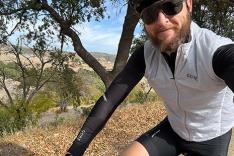So...How Fast Should You Pedal Indoors?
I haven't given a range of "acceptable" cadences in an indoor cycling class because the answer is "it depends". It depends on the skills and fitness of the rider and how much time is spent practicing. Just letting the legs spin fast out of control as happens in so many classes does not amount to practice. It is a waste of time. This is an excellent example of the adage "practice doesn't make perfect, only perfect practice makes perfect." You must perfect your technique first, then work on leg speed.
For the general population, I use an upper limit of 100 rpm for most indoor riders. I have many students in my classes who are challenged at cadences over 90 rpm, but that is because I'm a stickler for form, don't allow any bouncing, and always make sure they have some resistance on the bike. This is much more similar to being in an outdoor situation.
If you are a cyclist who already has a smooth pedal stroke and who is used to pedaling at 100 rpm or more outside, you certainly can do so indoors. Simply make sure that you are in control of the drive-train at all times and that you always have some resistance.
You will know when you are being pulled around by the flywheel—there is a sense of being pulled along, as if by a zealous dog on a leash. To avoid this, work on technique by spinning circles. Try to minimize the focus on the downward phase of the pedal stroke. You are already very good at the part—you did it on your tricycles! Focus more on the bottom and top halves of the pedal stroke. The more you relax the upper body and the hips, while sitting deeper in the saddle, the easier it is for the leg muscles to contract quickly. By learning to "spin" instead of "mash" on a bike with a flywheel, you will be less susceptible to being "ridden by the bike".
Check yourself in the mirror if there is one. You can see if you are bouncing. If there are no mirrors, have someone observe you from behind; it's more evident looking from the back. Once you start bouncing, you have exceeded your cadence "threshold". Back it down, and raise the resistance just a little until you find that right combination of resistance, at a cadence that is just beyond your comfort zone. For best results, do this without exceeding your anaerobic threshold; in other words, while staying aerobic and in control of your breath.
These tips are how you can improve your leg speed indoors and make sure that it translates to your cadence outdoors. If you do not commit this much time and focus indoors, then you will not likely find that your high-cadence pedaling in your standard, unaware, excessive-cadence indoor cycling classes has done you much good during the offseason.
Here's to riding faster!
- 3
- of
- 3
About the Author









Discuss This Article